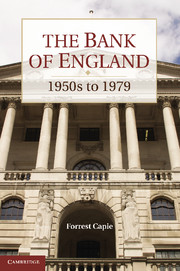Book contents
- Frontmatter
- Contents
- List of Illustrations
- List of Figures
- List of Tables
- Foreword by Mervyn King
- Preface
- Acknowledgements
- Abbreviations and Acronyms
- 1 Introduction and Overview
- 2 The Bank in the 1950s
- 3 The Monetary Setting and the Bank
- 4 The Bank's External Responsibilities to 1964
- 5 From Crisis to ‘Crucifixion’
- 6 Domestic Monetary Policy after Radcliffe
- 7 Other Activities and Performance
- 8 Sterling from Devaluation to Smithsonian
- 9 The Road to Competition and Credit Control
- 10 Competition and Credit Control
- 11 The Secondary Banking Crisis
- 12 Banking Supervision
- 13 Monetary Targets and Monetary Control
- 14 The Bank and Sterling in the 1970s
- 15 The Bank's Freedom to Operate
- 16 Epilogue
- Bibliography
- Index
- Titles in the series
3 - The Monetary Setting and the Bank
Published online by Cambridge University Press: 05 July 2011
- Frontmatter
- Contents
- List of Illustrations
- List of Figures
- List of Tables
- Foreword by Mervyn King
- Preface
- Acknowledgements
- Abbreviations and Acronyms
- 1 Introduction and Overview
- 2 The Bank in the 1950s
- 3 The Monetary Setting and the Bank
- 4 The Bank's External Responsibilities to 1964
- 5 From Crisis to ‘Crucifixion’
- 6 Domestic Monetary Policy after Radcliffe
- 7 Other Activities and Performance
- 8 Sterling from Devaluation to Smithsonian
- 9 The Road to Competition and Credit Control
- 10 Competition and Credit Control
- 11 The Secondary Banking Crisis
- 12 Banking Supervision
- 13 Monetary Targets and Monetary Control
- 14 The Bank and Sterling in the 1970s
- 15 The Bank's Freedom to Operate
- 16 Epilogue
- Bibliography
- Index
- Titles in the series
Summary
When the Governor Cameron Fromanteel Cobbold was being chauffeur driven in his Rolls Royce from his country seat, Knebworth House, to give evidence to the Radcliffe Committee, the car broke down. Cobbold and his chauffeur had to walk to the nearest railway station. Neither of them was carrying any cash. Cobbold approached the ticket clerk and said, ‘Now look, I am the Governor of the Bank of England but I don't have any money.’ There would be those in the following years who would have wished that he and his successors had taken a similar line with the long list of Chancellors who knocked on their door. The Radcliffe Committee began taking evidence in 1957 and completed its report in 1959. It was the most important document on money and banking in the period. Its origins lay in dissatisfaction with how monetary policy was believed to be working in the 1950s. The findings and recommendations provoked immense debate and subsequent controversy. It set the scene for the next decade. For the Bank though, the enquiry had relatively little impact on the way in which it conducted its operations. It prompted a little more openness, more research, and the provision of statistics, even if it could be argued that the Bank was already moving in that direction.
Antecedents: Old and New Orthodoxy
Before the First World War, a considerable body of central banking theory and practice developed.
- Type
- Chapter
- Information
- The Bank of England1950s to 1979, pp. 77 - 137Publisher: Cambridge University PressPrint publication year: 2010



